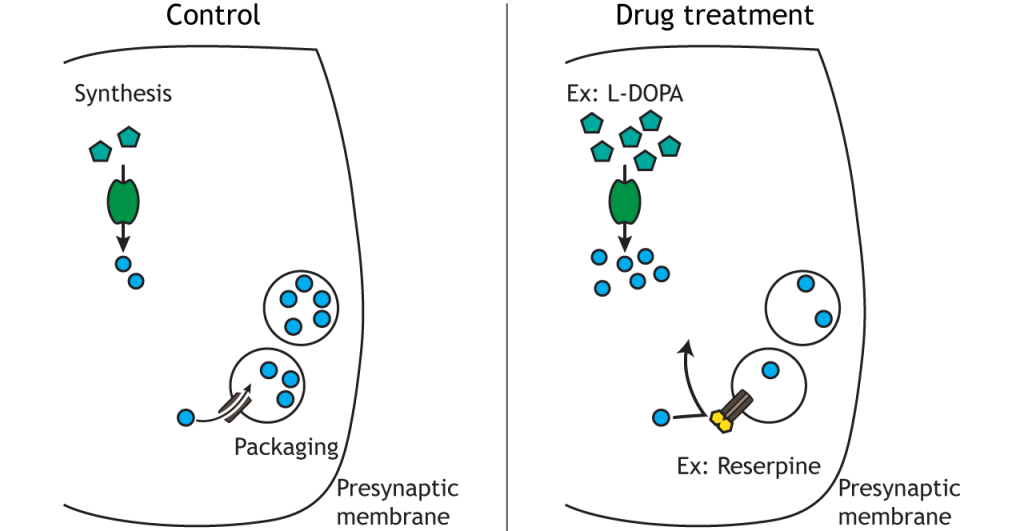16 Drug and Toxin Effects
Drugs and toxins can alter neuron functioning in a range of ways, from activation to inhibition and all levels of modulation. Although many drugs exist that alter molecular process typical of many cells, this lesson will focus on neuron-specific targets.
Drug and toxin effects can be excitatory, inhibitory, or modulatory
Synaptic Effects
As we have seen, the synapse is an incredibly complex structure, and for small molecule neurotransmitters, the entire “lifecycle” of the transmitter occurs in this space – synthesis, packaging, release, action, and termination. This means there are numerous targets upon which drugs and toxins can act and alter synaptic communication.
Drug Effects on Neurotransmitter Release
Some drugs affect neurotransmitter release by modulating neurotransmitter synthesis, either increasing or decreasing the amount produced in the terminal. One such drug is L-DOPA, a dopamine precursor molecule that increases dopamine production and is thus used as a treatment for Parkinson’s Disease.
Other drugs act on neurotransmitter packaging, which also impacts the amount released into the synapse. One example of such a drug is Reserpine, a treatment option for hypertension, which acts by blocking transport of monoamine transmitters into vesicles by inhibiting the vesicular monoamine transporter (VMAT). Reduced packaging into vesicles directly decreases the amount of neurotransmitter stored and thus and the amount of neurotransmitter released.

Drug Effects on the Postsynaptic Membrane
Neurotransmitter receptors are another critical target for drug and toxin action. Agonists mimic neurotransmitter effects, whereas antagonists block neurotransmitter effects. For example, muscimol, a component of some mushrooms, is an agonist for the ionotropic GABA receptor. Bicuculine, found in some plants is an antagonist that acts on the same receptor and blocks the action of GABA. Many other chemicals are able to modulate receptors in either a positive or negative fashion. Alcohol binds to the GABA receptor and increases the time the receptor is open when GABA binds.

Drug Effects on Neurotransmitter Clearance
Finally, neurotransmitter degradation and reuptake can also be altered by drugs and toxins. Depending on the neurotransmitter, enzymes located in either the synapse or in the terminal are responsible for degradation of the transmitter, and these enzyme can be blocked by drugs. Organophosphates are found in many pesticides and prevent the action of acetylcholinesterase, the enzyme that breaks down acetylcholine in the synapse. This inhibition increases acetylcholine action on the postsynaptic neuron. Monoamine oxidase inhibitors (MAOIs) prevent monoamine oxidase from degrading the biogenic amine neurotransmitters. MAOIs have been used as antidepressants since they increase the amount of transmitter available. Additionally, drugs can prevent the reuptake of neurotransmitters into the presynaptic terminal. Cocaine blocks the dopamine transporter, which results in increased action of dopamine in the synapse.

Non-Synaptic Effects
Drugs and toxins can also affect neuron function by acting outside of the synapse. For example, some chemicals change voltage-gated ion channel dynamics. Veratridine, a compound found in plants from the lily family, prevents voltage-gated sodium channels from inactivating. Initially, this causes an increase in neurotransmitter release, but it can quickly lead to excitotoxicity.
Key Takeaways
- There are many ways in which drugs and toxins can alter neuron function
- Effects can be excitatory, inhibitory, or modulatory

